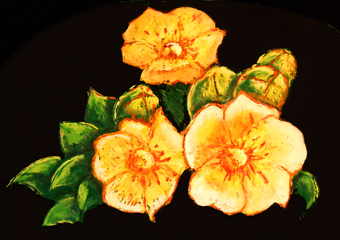 In the June 2012 issue of Sign Builder Illustrated, Jim Hingst writes about the process of reverse painting on glass. In the section called “Mixing Colors,” Hingst discusses: “For painting on glass, typically the medium is mixed in on the palette. The medium accelerates the drying process and acts as a thinner. If you still need to lower the viscosity of the paint, add a little turpentine.”
In the June 2012 issue of Sign Builder Illustrated, Jim Hingst writes about the process of reverse painting on glass. In the section called “Mixing Colors,” Hingst discusses: “For painting on glass, typically the medium is mixed in on the palette. The medium accelerates the drying process and acts as a thinner. If you still need to lower the viscosity of the paint, add a little turpentine.”
Due to space restrictions, we had to cut Hingst’s more in-depth discussion about the mediums, driers, thinners, and turpentine. However we’re presenting this information here in its entirety and to serve as an addendum to the published article.
Mediums
In the sign industry, boiled linseed oil is used to promote faster drying. Many old-timers will mix their own medium, using one part linseed oil with three parts turpentine.
Boiled linseed oil is generally safe for use with sign enamels or oil paints, because most of these paints use linseed oil as a binder or resin. As a paint additive, boiled oils will dry faster and produce a glossier finish.
The downside of boiled oils is that over time these oils will yellow and darken. It will also alter the color of the paints (especially whites, light colors, and blues).
When using a linseed/turpentine mixture or any other medium, keep the following facts in mind. The more medium you use, the more you dilute the color. The color also becomes more transparent and durability is compromised.
In mixing a linseed/turpentine mixture, you can alter the proportions. As you increase the amount of linseed oil, the medium is referred to as becoming fatter. As more turpentine is added, the mixture becomes leaner. Too much turpentine though can cause the pigment to break down. For this reason, you should never use more than 50 percent of any thinner in your medium.
The rule of thumb is to paint fat over lean. Failure to observe this widely held maxim can result in the paint cracking or wrinkling.
You can further modify the linseed/turpentine mixture by using driers, either a cobalt drier or Japan drier, to accelerate the curing process. (Note: More on driers to follow.)
If you use oil paints for an indoor application, you will find that these paints dry much more slowly than sign enamels or Japan paints. This extended open time allows you to blend colors and rework areas of your painting.
The disadvantage is that oil paints can take days to dry. Reds, blues, and purples dry especially slowly, compared to the earth tones.
Commercial mediums (such as Winsor Newton Liquin) are generally fat mediums, compared to linseed oil/turpentine mixtures, which are relatively lean. The advantage of a fat medium is that it has a prolonged open time. This allows you the time to rework your painting over a few days. If you want your painting to dry in a day or two, use a lean medium.
Driers
The evaporative process causes an oil paint to dry. Curing, though, is a completely different process. Curing refers to the polymerization of the resin, which occurs as the paint oxidizes and simple molecules crosslink to form more complex molecular structures. By attracting oxygen into paint, a cobalt drier accelerates drying times.
When adding any drier to paint, use care. As little as a drop or two added to a medium is all you need. As a rule of thumb, limit the amount of drier to less than 5 percent. Adding too much drier can cause problems (such as wrinkling, yellowing, and cracking). Cobalt driers can also alter the hue of paints (especially white).
Many of the old sign makers use Japan driers to speed up paint drying. The question that you need to ask is whether a drier is really necessary. If you are using a linseed oil/turpentine mixture as a medium, it will already accelerate drying.
Thinners
As a thinner, many painters prefer the old fashioned turpentine. Some people prefer mineral spirits.
Be aware that not all mineral spirits are created the same. Formulations vary from one manufacturer to another. Some formulations can alter the color of paints.
Before using mineral spirits, the best practice is to “Test, Don’t Guess.” Put a few drops on a white piece of paper. If it leaves a stain, it is not suitable as a thinner.
Turpentine
The old timers swear by turpentine. As a solvent, it is compatible with oil paints and sign enamels.
While it is a natural tree resin product, do not be fooled in thinking that it completely safe. Breathing the solvent fumes is harmful to your health, and turpentine will absorb through your skin and into your bloodstream.
Also be aware that the properties of one brand of turpentine can vary greatly from those of another. If you are a purist and want a pure product, buy the artist’s grade. It should be water clear. Most likely, the variety that you will find at your local hardware store will have some impurities.
Mineral Spirits
While you can use mineral spirits as a reducer, turpentine and Liquin may be better thinners. For cleaning, mineral spirits is a great solvent, that won’t harm your brushes, especially the more expensive natural hair brushes.
Do not use lacquer thinner as a cleaner though. It can ruin your brushes.
—Jim Hingst











